AXPONA 2024 Show Report, Part 3: Turntables and Tonearms From VPI, SUPATRAC, Tri-Art Audio, TW-Acustic, J.Sikora, Clearaudio, and More
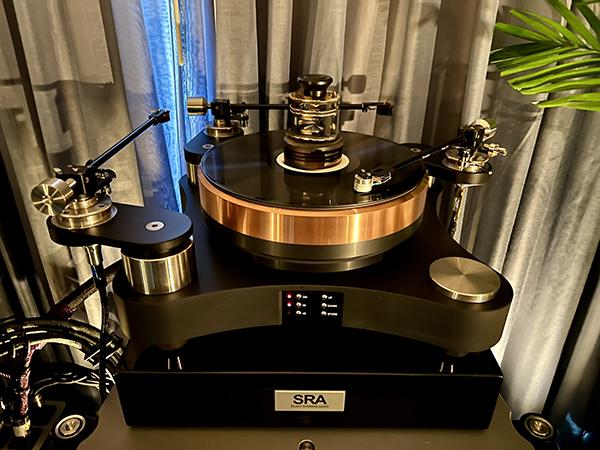
Welcome to Part 3 of my analog-focused report from AXPONA, which (as I also noted back in both Parts 1 and 2) took place April 12-14, 2024, at the Renaissance Hotel and Convention Center in Schaumberg, Illinois, in the greater Chicago metro area. There are plenty more turntables and tonearms I saw at the show to tell you about—and a few record cleaning machines too, for good measure — so let’s get right to it.

VPI & VTL
The Schaumberg F room had an enjoyable high-end demo system, including a VPl Titan Direct turntable ($60,000) with a Lyra Etna cartridge ($8,995) as the analog source ahead of VTL amplification — TP-6.5 Series II Signature phono preamp ($15,000), TL-7.5 Series III Reference line preamp, two pairs of MB-185 Series III Signature monoblock amps powering Stenheim Reference Ultime Two SX speakers (with Reference Platform), and Nordost cabling throughout.
Here, I finally got a proper listen to a couple of tracks from the 40th anniversary edition of Talking Heads’ Stop Making Sense — “Take Me to the River” for one. (In fact, it was VTL’s Bea Manley’s suggestion.) The soundstaging placement seemed to align with what’s in the original film — backup singers to the left and Tina Weymouth on bass to the right, with David Byrne in the center (and moving around). Imaging scale felt right for the room. Chris Frantz’s kick drum in the center was distinct, impactful. Handheld percussion was clean and lively. It was tempting to get up and dance, so propulsive and infectious were the rhythms. (If you like the sound of all that, you can read Mike Mettler and Mark Smotroff’s tag-team review of the Stop Making Sense 2LP set here.)
VPI turntables were seen in other rooms at the show, too. Another example was a VPI Prime Signature turntable with a VPI Shyla cartridge in a system with Gershman Acoustics 30th Anniversary Grand Avant Garde speakers ($18,000), which sounded far larger and fuller than their size, yet well-balanced. Amplification included a Pass Labs XP-17 phono preamp ($4,500) and a Pass Labs INT 250 integrated amp ($12,600).

Another setup featuring Stenheim speakers — in this case, the Alumine 3 SE speakers — also featured a handful of live performances from jazz saxophonist Jerome Sabbagh (seen above) accompanied by playback of one of his ensemble’s recordings, 2023’s Vintage (Sunnyside), on a demo system with a Technics SP-10R direct-drive turntable fitted with a Durand Tosca tonearm and a darTZeel CTH-8550 Mk II integrated amp with an MC phono preamp inside. Sabbagh, a Paris-native now based in New York City, has also given similar performances at other audio shows in recent years, including the aforementioned High End Munich.

SUPATRAC
Another new experience was learning about and listening to inventor Richard Braine’s patented SUPATRAC Blackbird tonearm. Braine (seen above) provided me with additional details about his design and setup.
The name, he told me, reflects its key features. “SUPA” stands for “Sideways Uni-Pivot Arm” and “TRAC” stands for “Torque Reaction which Assists Contact.” Braine’s design with a patented rotating pivot bearing improves upon traditional uni-pivot (and other) tonearm designs in two ways. One, the arm’s “trapeze” design prevents the arm from wobbling side-to-side; this helps it capture deeper bass. And two, the bearing’s surface is not parallel to the forces on it as it moves across the record surface, so there’s less tendency to scrape. “When I talk about scraping, we’re not talking about a few nanometers back and forth; not an inch. We’re talking about a tiny scale.” Braine’s SUPATRAC arm also differs from other designs in that its pivot point is positioned below the level of the record.

“Most tonearms have their pivot points maybe 10-15mm above the record,” Braine continued. “And the consequence of that is, when this yanking force of a loud signal [e.g., a drumbeat] happens at the cartridge, there’s actually an upwards pull that’s like a vertical bias because you’re pulling that way, and the pivot wants to turn upwards.” In other words, it wants to lift out of the groove.
In Braine’s design, with the pivot point below the record, when a loud signal happens, torque encourages the stylus downward into the groove. “As soon as you pull hard here because there’s a big drumbeat, it means the arm wants to come downwards — and so, downwards is good because it means you don’t see a reduction in the tracking force,” he explained. This also means smoother, more assured tracking.

The SUPATRAC Blackbird tonearm was demo’ed with a “fairly budget” Audio-Technica AT-33SA Shibata MC cartridge on the end. It was mounted to a modded, “stripped-down” Well-Tempered turntable (made by Opera Constance) with an extremely tiny/thin nylon filament belt. The turntable motor uses an Opera Constance wax engine.
The SUPATRAC arm’s tube is made of standard carbon fiber. It comes with a rigid lifter on top but the model at the show had the option Braine prefers — a string on top to lift it. “It’s one less thing to resonate in the arm structure,” he added. The SUPATRAC tonearm was first sold is the spring of 2021. Its SRP is $3,300, and it’s available direct and through authorized dealers.
The SUPATRAC demo with OePhi stand-mounted speakers and CAT amplification was both impressive and fun. Braine played Queen’s “Mustapha” (from November 1978’s Jazz), and a heavy-hitting electronic/industrial track — Extrawelt’s “Soopertrack” (originally a 2005 12in single). The cleanliness of attacks and bass extension was remarkable, and timing seemed impeccable. I detected no smearing. Excuse the hackneyed expression, but the SUPATRAC Blackbird tonearm could be a (wait for it) gamechanger.
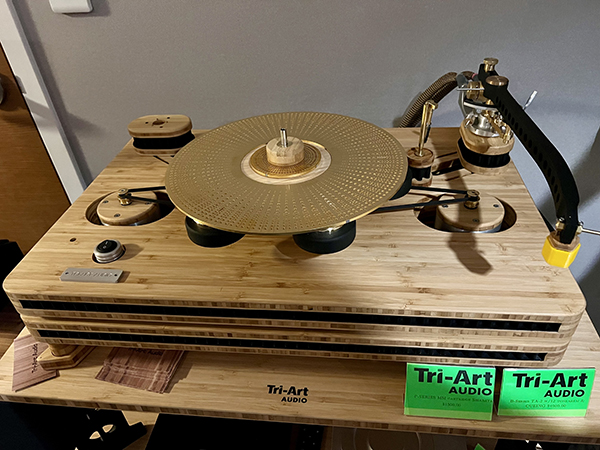
TRI-ART AUDIO & KUZMA
A 14th floor room featuring Linkwitz speakers had a couple of turntables on hand, including a Kuzma Stabi-R turntable ($9,500) on a Kuzma Platis 65 isolation platform ($4,560) that wasn’t in the active system at the time I was in the room. Ditto for a very unusual-looking turntable from Tri-Art Audio, an Ontario company I don’t recall having seen before — namely, their B-series TA-2 turntable (shown above), the plinth of which appeared to be made of bamboo and with a platter possibly made of brass, along with a 12in tonearm ($4,000) and a P-Series MM cartridge ($1.500). Some aspects of the Tri-Art aesthetic leaned toward DIY, but I’d love to find out more about the company and its design intentions.

TW-ACUSTIC & HIGH WATER SOUND
Another room with positive buzz that featured mono playback was High Water Sound’s room, where Jeff Catalano showed a TW-Acustic Raven LS-3 Copper turntable ($25,000; seen above) with 10.5in and 12in tonearms ($6,000 and $6,500, respectively). The former arm had a Fuuga cartridge ($10,000) attached, the latter a Miyajima Infinity Mono cartridge ($3,475), with signals from both entering a Raven Phono stage ($25,000). Other amplification from an Italian manufacturer called Alieno made its U.S. debut and glowed in the dark — not just the tubes, but also lines on their chassis.

The sound through the Cessaro Horn Acoustics Opus+ speakers ($55,000) and Opus subwoofers ($50,000) was at once soothing and energetic, exquisite in its detail on a couple of jazz tracks, including a mono live Miles Davis track “Stella by Starlight” off a Mobile Fidelity test pressing of My Funny Valentine: Miles Davis in Concert. (At least, I believe that’s what the show attendee said the LP was.)
The system also fared well on heavier material, deftly reproducing analog synths, and hard-hitting percussion on “Club Deuce” from The Serfs’ 2023 Half Eaten by Dogs album I’d brought. On “Linea,” a track that features the early-career Labèque sisters on two pianos, from my Berio Conducts Berio LP with The London Sinfonietta, their delicate-to-forceful dynamic piano action was pleasingly conveyed. Images of the instruments spread out and seemed well-distributed throughout the soundstage.

J.SIKORA
At least a couple of rooms contained J.Sikora turntables, one being in another room with DeVORE speakers, the smaller O/Baby speakers ($5,700). Here, a J.Sikora Initial turntable with a glass platter mat and Panzerholtz platter outfitted with an Origin Live Zephyr 12in tonearm ($1,700) and an Aidas Durawood cartridge ($4,950) feeding its MC signal into a Sutherland TZ Vibe phono stage ($1,400) ahead of a Naim Uniti NOVA integrated amp ($6,899) driving the DeVORE speakers. Cabling was from Wireworld.
The sound was surprisingly full and punchy on both the ostensible end of The Beatles’ eternally classic 1969 Abbey Road LP (“Carry That Weight” and “The End”) as well as on a Kraftwerk cut, “Non Stop,” the opening track from their Remixes LP release from 2020, with much more low-end impression than expected.
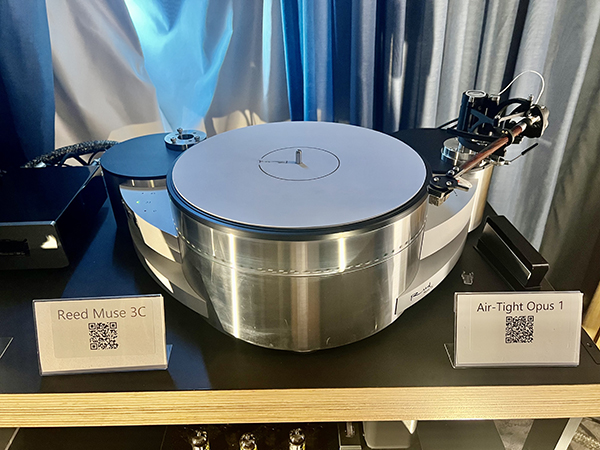
REED, TRANSROTOR & AXISS AUDIO
Axiss Audio presented turntables in their rooms, including a Reed Muse 3C turntable with a Reed 5A tangential tracking tonearm made of Cocobolo wood to which an Air Tight Opus 1 cartridge was attached. There was also an Air Tight ATH-3S step-up transformer and other Air Tight amplification I didn’t have a chance to hear, as closing time was drawing near.
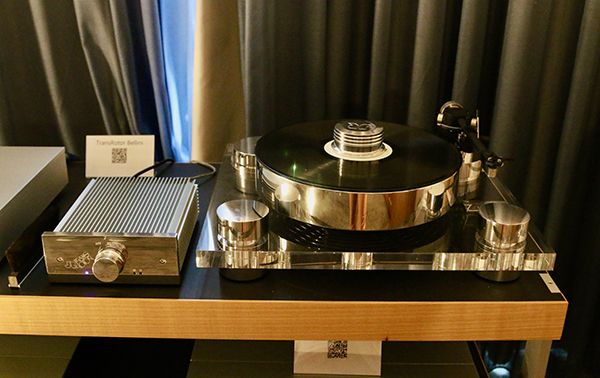
However, I did get to listen briefly in a couple of other Axiss rooms, one with a new Transrotor Bellini TMD turntable ($6.495; seen above) with Transrotor Studio 9in tonearm ($5,595) and an MC Transrotor Tamino cartridge ($18,975). There, Gauder Akustik Capello 100 speakers ($25,975/pr) were demo’ed with new Soulution electronics from the Swiss company’s latest 3 Series of five components — a 350 phono preamp, 326 preamp, 331 integrated amp, 312 power amp, and 360 DAC. SRPs for those products range from $21,475 to $28,975. Sound in here was well-balanced and articulate. On “Minas de Cobre,” from my 2013 Calexico Spiritoso LP, the brass section came through with convincing color and timbre.

A larger-scale (and larger-budget) system from Axiss was in the 16th floor Aster Suite, with top-shelf components of the aforementioned brands. Larger Gauder Akustik DARC 250 Mk II 4-way Reference loudspeakers ($249,975/pr) were paired with high-end Soulution amplification, including a new Soulution 757 De-Emphasis EQ phono preamp ($84,975) and a new Soulution 727 preamp with phono module inside ($89,950).

The analog source was a Transrotor Tourbillon Reference turntable ($47,975 base price; seen above) on its own optional Tourbillon stand ($15,975). The pickup was a DS Audio Grand Master EX optical cartridge ($22,500) that usually requires its own phono preamp/EQ — but here, the Soulution gear handled those functions. Beyond playback that was more highly resolved, a major difference here appeared to be dimensionality, both of images and their placement within a 3-D soundstage.

GARRARD & RHYTHM DISTRIBUTION
This AXPONA marked Craig Hoffman and Randy Bingham’s first show under their new Rhythm Distribution company banner. In one of Rhythm Distribution’s two rooms, I caught a bit of one of Cadence Distribution’s Kat Ourlian’s LP spinning sessions on a Garrard Model 301 Advanced turntable with an SME Series V tonearm ($54,900; shown above) with an Ortofon MC Diamond phono cartridge ($9,999) attached, sending signals to a Goldmund Mimesis PH3.8 NEXTGEN phono preamp ($48,000) and other Goldmund amplification.
The Tannoy speakers were the system’s relative bargain, priced at just $12,500/pr. The first couple of tracks from Todd Terje’s 2014 LP It’s Album Time (which I’d only heard digitally on Qobuz and Tidal before this), showed good rhythmic interest and flow.
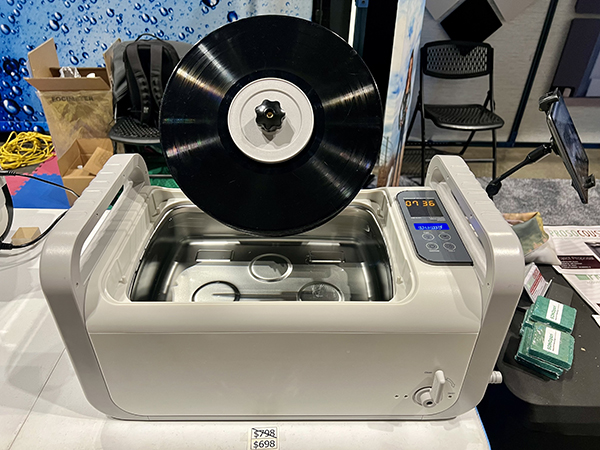
ISONIC INC.
In the Expo Hall, Jerry Fan, president of iSonic Inc. record cleaning machines, displayed several of his models, including his first design that repurposes a tank that’s normally used to clean dental instruments ultrasonically. Kind of like the washer-and-dryer combo machines found in Europe, Fan’s RCMs wash and dry vinyl records within the same tank space. While some of his upper-tier RCMs, such as the CS6.2-PRO ($1,199), might take a bit more time to do the job — about 10 minutes to wash, and 8-10 minutes to dry, he said — they’re efficient in being able to clean and dry up to 10 LPs at once. The CS6.2-PRO also offers spin drying — an industry first, according to Fan.
Also in the Expo Hall, Keith Monks, whose eponymous RCMs made of bamboo were covered in Part 2 of my report from last year’s AXPONA, showed his latest special edition Prodigy machine with a U.S. flag and Union Jack flag combo design. Custom designs are also available in addition to what was also shown in Elite AV Distribution’s room upstairs, along with active sonic demos. (It’s one of a handful of rooms I was sad to have missed this time around.)

ESOTERIC
The Esoteric room displayed the company’s first-ever turntable, the Esoteric Grandioso T1 ($80,000), a table created to commemorate the Japanese company’s 35th anniversary a couple of years back. It was playing in a system ahead of an Esoteric E-02 phono preamp ($9,500) and other Esoteric components with PMC speakers, plus Esprit cabling.

CLEARAUDIO
Assorted turntables from Clearaudio, such as a limited-edition Master Jubilee (seen above) held court inside — and outside, on static display — Quintessence Audio rooms. There were a couple of new introductions too, such as the Clearaudio Signature turntable with Signature Black Carbon tonearm ($4,000) with a new DS Audio E3 optical cartridge ($1,375) and partnering E3 EQ phono EQ ($1,375). (You can read more about the Signature table, seen below, in our earlier report on it here.)

FINI (FOR NOW)
Just a few more notes to wrap things up. A glowing McIntosh MT 10 Precision turntable also graced the ground level area outside demo rooms in a full-blown McIntosh amplification setup powering Sonus Faber speakers. Elsewhere, Jeff Joseph’s and Nick Doshi’s demo system included a J.Sikora Standard Max 15th Anniversary turntable with an Aidas Mammoth Gold cartridge, along with new Joseph Audio Pearl Graphene Ultra speakers and tubed amplification from Doshi Audio. That room also featured promotion for Adam Czerwiński’s AC Records, a label out of Poland that produces limited-edition LPs with mastering and cutting at Abbey Road Studios, along with reel-to-reel tapes — first copies from master tapes, the company says — and CDs.
Unfortunately, my return to Wynn Audio’s room this time around did not happen. It turns out they were showing a Thiele Audio TT01 turntable using three layers in a constrained layer damping design, shown with TA01 tonearm ($28,000) from Helmut Thiele, a designer for more than 25 years whom the company has recently begun working with. Also part of this turntable demo system were an Ortofon Verismo MC cartridge ($6.999) and optional upgrade accessories from Thiele, including a damping weight ($1.000), platter mat ($230), and an active suspension platform ($18,000).
And that’s all I have for this three-part show report. Not unexpectedly, AXPONA 2024 became a case of too many turntables, too little time. There were several other important turntable makers whom I just wasn’t able to spend as much time with as I’d have liked at this show — but I will next year! See you there!
Author bio: Julie Mullins, a lifelong music lover and audiophile by osmosis who grew up listening to her father’s hi-fi gear, is also a contributing editor and reviewer on our sister site, Stereophile, for whom she also writes the monthly Re-Tales column. A former fulltime staffer at Cincinnati’s long-running alt-weekly CityBeat, she hosts a weekly radio show on WAIF called On the Pulse.
If you’d like to see even more of our AXPONA coverage, check out Part 2 of Julie Mullins’ AXPONA turntables coverage here and Part 1 here, Ken Micallef’s turntable-centric video report here, Mike Mettler’s look at Luxman’s new PD-191A turntable and E-07 phono preamp and his review of the Acoustic Sounds Atlantic 75 vinyl listening session here, and Mettler’s Day 1 photo essay here.







































